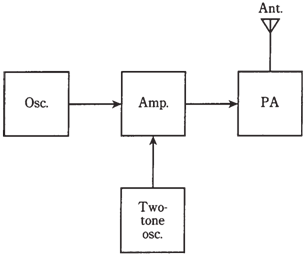Frequency-shift keying
Morse code keying is the primitive form of the amplitude modulation (AM). The strength, of the signal is varied between 2 extreme conditions: full-on and full-off. There is another manner to achieve 2-state keying which works better with

Figure--The Morse code word ‘eat’ as sent on CW.
teleprinter machines than on off switching. To shift the frequency of carrier wave back and forth. It is termed as frequency-shift keying (FSK).
Teleprinter codes
The Morse code is not only digital code of its type. There are 2 common teleprinter codes used to send and receive the radioteletype (RTTY) signals. These codes are called as the Baudot and ASCII (pronounced “ask-ee”) codes. A carrier wave can be keyed on and off by using either of these codes, at the speeds varying from 60 wpm to over 1000 wpm. In the recent years, ASCII has been replacing Baudot as standard teleprinter code.
A special circuit, called as terminal unit, converts the RTTY signals into the electrical impulses to work a teleprinter or to display characters on a monitor screen. The terminal unit generates the signals which are necessary to send RTTY, as the operator types on keyboard of a teleprinter terminal. A personal computer is made to work as RTTY terminal by terminal emulation software. This software is available in many different forms, and is popular among the radio amateurs and electronics hobbyists.
Mark and space
The difficulty with using simple on-off keying for RTTY is the noise pulses, such as thunderstorm static crashes, are interpreted by the terminal unit as signal pulses. This generates misprints. There is no problem if a crash occurs during the full-on, or mark, part of signal; but if it occurs during a pause or space interval, the terminal unit is fooled into thinking it is a mark pulse instead.This problem can be solves greatly by sending a signal at the time of space part of the signal, but at a different frequency from mark pulse. Then the terminal unit for sure a mark is not being sent. Rather than of sending Not mark, the transmitter sends ‘Not mark, but space instead’. The easiest way to do this is to send the mark part of the signal at one carrier frequency, and space part at another frequency a few hundred hertz higher or lower. This is FSK. The difference between mark and space frequencies is called as shift, and is between 100 Hz and 1 kHz.
A frequency-versus-time graph of Morse code word “eat,” sent by using FSK, is shown in the figure given below. Normally, Baudot or ASCII, instead of Morse, is used for teleprinter operation. A block diagram of FSK transmitter is shown in the given below. The FSK mode, like on off code keying, is the digital form of communications. But no like on-off Morse keying, FSK is the frequency modulation (FM).

Figure--A simple FSK transmitter
The telephone modem
Teleprinter data is sent over the telephone lines by using FSK entirely within audio range. Two audio tones can be generated, one for mark and other for space. There are 3 sets of standard tone frequencies: 1200 Hz and 2200 Hz for the general communications, 1070 Hz and 1270 Hz for the message origination, and 2025 and 2225 Hz for answering them. This signifies shifts of 1000 Hz or 200 Hz.As this FSK takes place at audio, it is called as audio-frequency-shift keying (AFSK). A device which sends and receives AFSK teleprinter over phone lines is called as a telephone modem. If you have used a personal computer by means of the phone lines, you have used a telephone modem. Perhaps you have heard the bleep-bleep of the tones as data is received or sent.